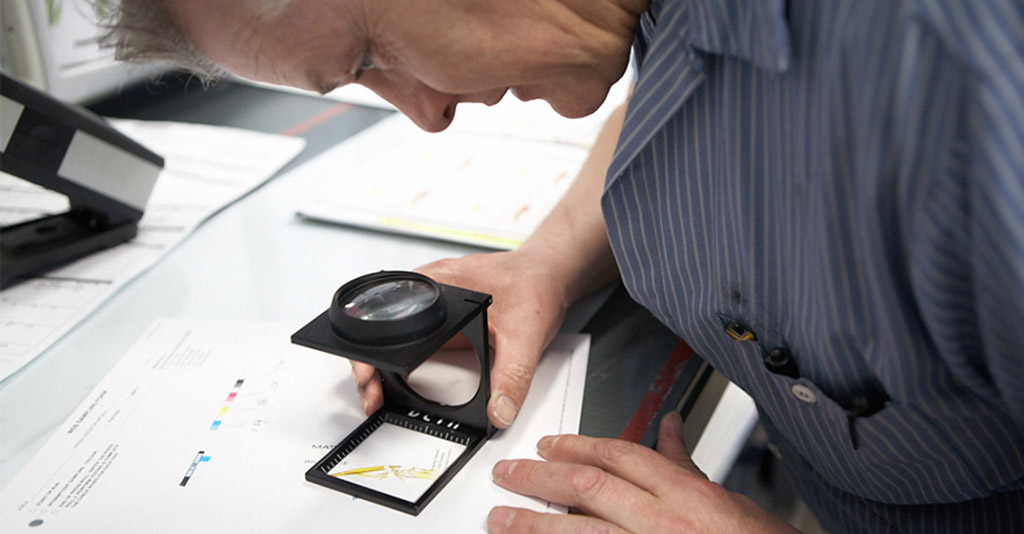Pre-press before printing is like pre-op before surgery

When you strip away all the glitz and glam of product labeling — Consumer trends! Branding! Embellishments! — you uncover one unifying requirement every brand owner has for their labels:
Identical colors and graphics, label after label and order after order.
And the foundation for achieving that level of consistency is laid long before your labels are ever run on the press. It begins with the upfront work done by pre-press.
In this article, we’ll help brand owners by explaining:
- How the role of pre-press before label printing is similar to that of pre-op before surgery
- What brand owners can do to better facilitate the pre-press workflow
- The many ways experienced pre-press departments add value to their label projects
- The benefits of having pre-press and printing under one roof
Let’s get started.
Understanding the important role pre-press plays
In the label printing process, there are three key stakeholders (the designer, the pre-press department and the printer) collaborating to achieve one goal — making the brand owner (read: you) happy with the final, printed result.
You likely know the role of the designer and printer in making this happen, but the role of pre-press remains a mystery.
After all, why can’t your designer’s artwork just go straight to press?
The similarities between pre-press and pre-op
To indulge in a metaphor, the pre-press workflow is to label printing what the pre-op checkup is to medical surgery.
You’d never go straight to surgery — you’d go through a series of pre-op appointments and tests to ensure you’re healthy enough for surgery, and to make sure they modify the surgery to your individual needs. This step is necessary to guarantee the best surgery results.
Similarly, your label design shouldn’t go straight to press without first ensuring the design is fine-tuned to produce your desired results using the printing technology that will be used.
Pre-press is essentially the pre-op of label printing — and the pre-press workflow contains all the in-between tasks necessary to ensure your label design is ready for press.
Label printing is, after all, a manufacturing process with tolerances and limitations. The pre-press department is intimately aware of the intricacies of digital and flexographic printing, as well as the calibration profiles of the individual presses on which your labels will be printed.
They translate your expectations for the finished label into color targets and process controls that the printer can use to meet them. They apply traps, re-orient barcodes and resize type as needed to transform the original artwork file into a printable design. And they produce the press proof against which all stakeholders can objectively evaluate the color and image quality of finished label orders.
Essentially, the pre-press team will filter your requirements through the lens of their expertise, ensuring the printability and reproducibility of your brand artwork.
Not every label printer offers extensive pre-press services. But skipping pre-press increases the risk of simply printing labels that don’t meet your requirements.
Your responsibility during pre-press
It’s paramount that you communicate your requirements for the finished label clearly, and early on in the process.
At the outset of any new label printing job, you’ll be asked questions like:
- What substrate will this be printed on?
- If you’re using a metallized material, which parts should be reflective and which parts should be non-reflective?
- Which areas, if any, should get a pattern varnish, embossing or any other embellishment?
- What, exactly, are your color expectations? Where do we need to use spot colors to meet your brand standards?
- And other questions that aim to get at the root of what you require out of your labels.
All stakeholders will use your stated expectations as the basis for all production decisions because, ultimately, your vision is the target they are trying to hit. The clearer you are about defining that target, the better the end result will be.
Pre-press adds value by ensuring brand consistency
After that initial expectation-setting conversation, a lot of the pre-press team’s work happens behind the scenes with the designer and the printer. Although you might not see much of the pre-press workflow, the value it adds to the label printing process is far-reaching:
- Quality and consistency are engineered into the labeling process
- Printing problems (e.g., unreadable barcodes, illegible text, vignette banding, gaps between adjacent colors, etc.) are prevented
- Digital, flexographic and offset presses are all very different. The pre-press department will understand the tolerances and limitations of the technology that will be used to print your labels, and optimize your label artwork to ensure it will print the way you and your designer envision
- You can objectively evaluate whether each printed label meets your brand’s numerically defined color targets using a spectrophotometer, an instrument which quantitatively measures color (e.g., only PANTONE 300C Blue ΔE ≤ 2.0 will be acceptable)
- Your press proof will, to a high level of accuracy, let you see what the printed product will look like, allowing you to make adjustments before plates are made* and your order is sent to press
- Lead times can be reduced, especially when pre-press, platemaking* and printing are all under one roof
*Platemaking is only necessary for flexographic label printing. Digital label printing does not require plates.
The benefit of having pre-press and printing under one roof
Pre-press is the quality control gateway that your label artwork goes through to ensure it can be replicated digitally or flexographically, order after order.
It is, in essence, the art of accurate prediction. And when the pre-press and printing are under one roof, making good predictions is all the easier.
The pre-press department has all the press calibrations and configurations necessary to efficiently prepare artwork for a particular press. They can verify that the appropriate ink and press maintenance is being performed, to ensure the most optimized press scenario. Plus, communication is streamlined — all processes and quality checks were created together as one, unified team.
Having end-to-end control of the manufacturing process also speeds up the velocity of the design-to-print process. There’s a seamless transition between graphics, proof approval, platemaking (for flexographic presses) and printing, reducing the overall lead time between first contact and delivery.
For you, the brand owner, having the pre-press and printing on the same team also means there is single-source responsibility for the quality of your printed labels.
Even with technology advancements, expertise matters
Decades ago, the pre-press workflow was done entirely by hand. With computer and software advancements, automated processes have replaced analog ones and the pre-press department can predict printed results with much greater accuracy than ever before.
We’ve witnessed this shift firsthand, and have invested in state-of-the-art platemaking technology, automated pre-press workflows and the latest presses. Today, we even have a customer-facing portal from which you can upload artwork and approve proofs.
But we’ve found that brand expectations have risen in tandem with these improvements, and all the tools in the world don’t mean a thing if you don’t have the expertise to get the most out of them. When evaluating printers based on their pre-press capabilities, look to expertise — not technology — to evaluate whether they’re a good fit.
If you’d like to know more about our in-house pre-press services, or you’re ready to talk about your brand’s labeling challenges, reach out to our team today.
Find the best solution that makes the most sense for your brand.
Tags:


